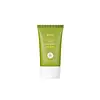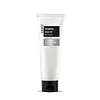What's inside
What's inside
 Key Ingredients
Key Ingredients

 Benefits
Benefits

 Concerns
Concerns

 Ingredients Side-by-side
Ingredients Side-by-side

Water
Skin ConditioningDibutyl Adipate
EmollientPropanediol
SolventPolymethylsilsesquioxane
Diisopropyl Sebacate
EmollientDiethylamino Hydroxybenzoyl Hexyl Benzoate
UV FilterEthylhexyl Triazone
UV AbsorberMethylene Bis-Benzotriazolyl Tetramethylbutylphenol
UV FilterCoco-Caprylate/Caprate
EmollientDiethylhexyl Butamido Triazone
UV AbsorberButylene Glycol
HumectantGlycerin
Humectant1,2-Hexanediol
Skin ConditioningCaprylyl Methicone
Skin ConditioningHouttuynia Cordata Extract
Skin ConditioningPentylene Glycol
Skin ConditioningBehenyl Alcohol
EmollientPolyglyceryl-3 Methylglucose Distearate
EmulsifyingDecyl Glucoside
CleansingTromethamine
BufferingCarbomer
Emulsion StabilisingAcrylates/C10-30 Alkyl Acrylate Crosspolymer
Emulsion StabilisingSodium Stearoyl Glutamate
CleansingPolyacrylate Crosspolymer-6
Emulsion StabilisingEthylhexylglycerin
Skin ConditioningXanthan Gum
EmulsifyingT-Butyl Alcohol
PerfumingTocopherol
AntioxidantWater, Dibutyl Adipate, Propanediol, Polymethylsilsesquioxane, Diisopropyl Sebacate, Diethylamino Hydroxybenzoyl Hexyl Benzoate, Ethylhexyl Triazone, Methylene Bis-Benzotriazolyl Tetramethylbutylphenol, Coco-Caprylate/Caprate, Diethylhexyl Butamido Triazone, Butylene Glycol, Glycerin, 1,2-Hexanediol, Caprylyl Methicone, Houttuynia Cordata Extract, Pentylene Glycol, Behenyl Alcohol, Polyglyceryl-3 Methylglucose Distearate, Decyl Glucoside, Tromethamine, Carbomer, Acrylates/C10-30 Alkyl Acrylate Crosspolymer, Sodium Stearoyl Glutamate, Polyacrylate Crosspolymer-6, Ethylhexylglycerin, Xanthan Gum, T-Butyl Alcohol, Tocopherol
Water
Skin ConditioningTitanium Dioxide
Cosmetic ColorantAluminum Hydroxide
EmollientStearic Acid
CleansingCyclomethicone
EmollientPEG-10 Dimethicone
Skin ConditioningIsohexadecane
EmollientZinc Oxide
Cosmetic ColorantMethicone
EmollientEthylhexyl Methoxycinnamate
UV AbsorberIsoamyl P-Methoxycinnamate
UV AbsorberCyclopentasiloxane
Emollient4-Methylbenzylidene Camphor
UV AbsorberGlycerin
HumectantCetyl PEG/PPG-10/1 Dimethicone
EmulsifyingDisteardimonium Hectorite
StabilisingIsononyl Isononanoate
EmollientBeeswax
Emulsion StabilisingOzokerite
Emulsion StabilisingSodium Hyaluronate
HumectantAloe Barbadensis Leaf Extract
EmollientCamellia Sinensis Leaf Extract
AntimicrobialCollagen Extract
Skin ConditioningMyrciaria Dubia Fruit Extract
Skin ConditioningMalpighia Emarginata Fruit Extract
Skin ConditioningMagnesium Sulfate
Hydrogenated Lecithin
EmulsifyingLinoleic Acid
CleansingCeramide NP
Skin ConditioningTea-Cocoyl Glutamate
CleansingCaprylic/Capric Triglyceride
MaskingCamellia Japonica Seed Oil
EmollientPhenoxyethanol
PreservativeEthylhexylglycerin
Skin ConditioningParfum
MaskingWater, Titanium Dioxide, Aluminum Hydroxide, Stearic Acid, Cyclomethicone, PEG-10 Dimethicone, Isohexadecane, Zinc Oxide, Methicone, Ethylhexyl Methoxycinnamate, Isoamyl P-Methoxycinnamate, Cyclopentasiloxane, 4-Methylbenzylidene Camphor, Glycerin, Cetyl PEG/PPG-10/1 Dimethicone, Disteardimonium Hectorite, Isononyl Isononanoate, Beeswax, Ozokerite, Sodium Hyaluronate, Aloe Barbadensis Leaf Extract, Camellia Sinensis Leaf Extract, Collagen Extract, Myrciaria Dubia Fruit Extract, Malpighia Emarginata Fruit Extract, Magnesium Sulfate, Hydrogenated Lecithin, Linoleic Acid, Ceramide NP, Tea-Cocoyl Glutamate, Caprylic/Capric Triglyceride, Camellia Japonica Seed Oil, Phenoxyethanol, Ethylhexylglycerin, Parfum
 Reviews
Reviews

Ingredients Explained
These ingredients are found in both products.
Ingredients higher up in an ingredient list are typically present in a larger amount.
Ethylhexylglycerin (we can't pronounce this either) is commonly used as a preservative and skin softener. It is derived from glyceryl.
You might see Ethylhexylglycerin often paired with other preservatives such as phenoxyethanol. Ethylhexylglycerin has been found to increase the effectiveness of these other preservatives.
Glycerin is already naturally found in your skin. It helps moisturize and protect your skin.
A study from 2016 found glycerin to be more effective as a humectant than AHAs and hyaluronic acid.
As a humectant, it helps the skin stay hydrated by pulling moisture to your skin. The low molecular weight of glycerin allows it to pull moisture into the deeper layers of your skin.
Hydrated skin improves your skin barrier; Your skin barrier helps protect against irritants and bacteria.
Glycerin has also been found to have antimicrobial and antiviral properties. Due to these properties, glycerin is often used in wound and burn treatments.
In cosmetics, glycerin is usually derived from plants such as soybean or palm. However, it can also be sourced from animals, such as tallow or animal fat.
This ingredient is organic, colorless, odorless, and non-toxic.
Glycerin is the name for this ingredient in American English. British English uses Glycerol/Glycerine.
Learn more about GlycerinWater. It's the most common cosmetic ingredient of all. You'll usually see it at the top of ingredient lists, meaning that it makes up the largest part of the product.
So why is it so popular? Water most often acts as a solvent - this means that it helps dissolve other ingredients into the formulation.
You'll also recognize water as that liquid we all need to stay alive. If you see this, drink a glass of water. Stay hydrated!
Learn more about Water